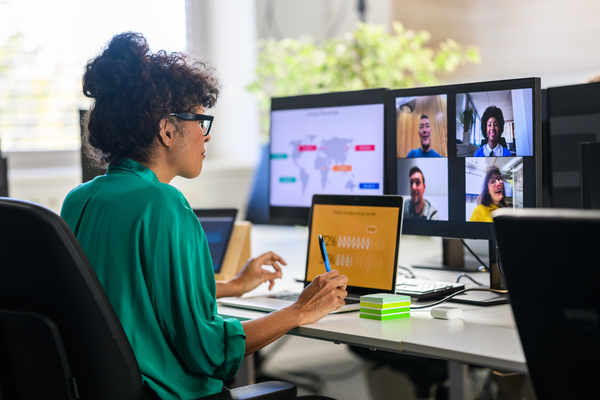Reimagining spaces: physical locations for the digital age

Jon Blakeney at I-AM discuss the challenges and opportunities that the shift to digital transactions presents, and explores the innovative strategies that will enable financial institutions to thrive in the digital age
The global digital shift has revolutionised how we use physical spaces in retail and other industries. Accelerated by the pandemic, online transactions have become the norm.
Yet, amid this surge towards the virtual, certain businesses – from banks to health, wellness, and luxury fashion sectors – are rethinking their physical locations. They’ve recognised the importance of robust physical touchpoints, spurred on by evolving consumer behaviours.
While online convenience is great, people still crave advice, human interaction, or simply a space beyond their homes.
For businesses revamping their physical spaces, the question isn’t just about their value in a digital world. It’s about delivering precisely what their customers truly need – and that is the real challenge.
Exploring enhanced offerings
For banks, the challenge lies in dwindling branch engagements and rising operational costs. However, this presents an opportunity to transform spaces overdue a revamp. Some banks are already pivoting to offer more than financial services by becoming “knowledge hubs”, which provide spaces not only for complex advice but also for networking and idea sharing.
An example is the ‘10000 Small Businesses’ initiative from Goldman Sachs, designed to provide high-quality, practical education and support to leaders of high-growth small businesses across the UK. The initiative is run in conjunction with Oxford University and shows the power of blending business and learning institutions.
Banks have an opportunity to play a crucial role in the link between financial wellness and people’s overall health – particularly pertinent in today’s economic climate – by becoming places where customers can discuss major life decisions in an open and welcoming environment.
There is huge potential in banks using their physical spaces to re-establish themselves as pillars of the local community, connecting and supporting the community.
Understanding the diverse needs of communities, consulting, and involving them from the outset will establish stronger brand connections. For any sector, this is the key to ensuring longevity in consumer relationships.
The healthcare and wellness sector is undergoing a similar soul-searching exercise. Pharmacies, in particular, are witnessing a growing trend of online prescription management, pushing these spaces towards a more holistic view of health. This could be through offering consultations or mental and physical health support, rather than focusing on the products on the shelves. Some innovative pharmacies are beginning to offer lifestyle consultations, such as training and diet advice for new runners. These offerings create a long-term relationship that’s more than purely transactional.
In healthcare more generally, there’s a positive movement towards wellness and prevention, rather than merely finding a cure to an existing problem. Repurposing the sector’s lesser used physical spaces supports that and has the added bonus of reducing the pressure on primary healthcare services like the NHS.
One example is Maggie’s, a charity that supports people affected by cancer by focusing on physical spaces of support, highlighting the potential of well-designed physical spaces to enhance well-being.
Getting it right
To use physical spaces in the most productive way possible means understanding who the business is as a brand and what fits within that.
In the luxury fashion sector, brands are using physical locations to strategically target their customers: for Dior, that was launching a pop-up on the lavish island of Capri, for Jacquemus, it was a pop-up in Lake Como, for Chanel, the Hamptons. It gives the brand an extended footprint, creating new physical touch points that will also fuel online sales, becoming a brilliantly blended ecosystem.
There are, of course, challenges to physical spaces: they are more expensive, difficult to change, and demand a different employee skillset. A digital footprint can be changed instantaneously, while we can still see the echoes of old brands etched across Britain’s buildings (think Woolworths).
It’s not easy to get it right: Amazon, one of the world’s most innovative businesses, had fallen short of expectations with its attempts to enter physical retail in the UK. People usually love the timesaving use of technology, such as removing tills – but Amazon Fresh hasn’t found the right balance between great retail practices, and innovation.
To attract consumers off their sofas, it is still essential to offer a great customer experience, at every stage of their journey.
On the other hand, the freshly launched Battersea Power Station is a great example of how a physical space can be repurposed. The space is already hugely popular, combining all the elements of lifestyle into one place: retail, living spaces, hotels, food offerings from Gordon Ramsey to fast food, activities for children, and spaces for local to enjoy for free.
Often when we talk about the future we’re talking a long way ahead, but there are great examples – from banks to Battersea – that businesses can already look to for inspiration. Physical spaces allow visibility to brands in a way that you can’t replicate online and foster connections with consumers that last longer.
There are so many disused buildings around the UK, if brands start thinking innovatively, we could soon have a roster of incredibly inspiring physical spaces in our future.
Jon Blakeney is co-founder of experiential design agency I-AM
Main image courtesy of iStockPhoto.com

Business Reporter Team
Most Viewed
Winston House, 3rd Floor, Units 306-309, 2-4 Dollis Park, London, N3 1HF
23-29 Hendon Lane, London, N3 1RT
020 8349 4363
© 2025, Lyonsdown Limited. Business Reporter® is a registered trademark of Lyonsdown Ltd. VAT registration number: 830519543





